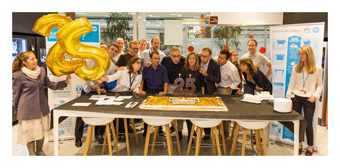With over 3.3 million HP DesignJet products sold since its first large format printer in 1991, HP DesignJet celebrates its twenty-fifth anniversary with Matias del Campo, architect and co-founder of SPAN Architects, who reflects on some of his career milestones with HP DesignJet technology.
HP had already launched 54 products and registered over 2,200 patents when Matias del Campo first began printing his plans at a local copy shop on the HP DesignJet 1000, introduced in 1999. At that time, an A1/D-sized line drawing printed in under half the time as the first HP DesignJet, about 1.5 minutes, and at higher quality.
“The quality of line drawings and the print speed were amazing. I could illustrate even very complex designs very clearly, whether they were CAD line drawing or full color renderings,” said Matias del Campo, architect and co-founder, SPAN Architects. “With every new HP DesignJet, I thought ‘this has to be the maximum that the technology can achieve.’ And each time they are faster and image quality is higher. Now, it is what I expect from HP.”
When del Campo set up SPAN Architects with architect Sandra Manninger in 2003, HP DesignJet had recently introduced a family of affordable multi-format printers, allowing SPAN to compete with established design studios.
“For a small studio starting out on a limited budget, our multi-format HP DesignJet printer was perfect. We saved print costs on outsourcing but more importantly, we could compete for more projects, at least one a week. HP has democratized the ability to compete for projects. You don’t need to be a large company to own and run an HP DesignJet printer, but you can compete on a larger scale,” del Campo states.
 Today SPAN Architects, with offices in Detroit in the U.S. and Shanghai in China, leverages leading edge construction methods and technologies to create affordable projects with appealing designs. Projects are printed and shared using a 36-inch, web-connected HP DesignJet T920 Printer. SPAN is currently involved in the interior design of flagship stores for world-renowned brands in a number of locations in China and designing a 1,200 housing unit development project in Jakarta, where they are exploiting modular construction techniques to create distinct, attractive designs that remain affordable.
Today SPAN Architects, with offices in Detroit in the U.S. and Shanghai in China, leverages leading edge construction methods and technologies to create affordable projects with appealing designs. Projects are printed and shared using a 36-inch, web-connected HP DesignJet T920 Printer. SPAN is currently involved in the interior design of flagship stores for world-renowned brands in a number of locations in China and designing a 1,200 housing unit development project in Jakarta, where they are exploiting modular construction techniques to create distinct, attractive designs that remain affordable.
“What really has amazed me over the years is HP’s ability to consistently develop and incorporate solutions and services that transform the design workflow for architects. HP reaches out to designers and creates easy-to-use solutions that respond to our needs. As a student in architecture, I used an HP DesignJet printer to print my first plans. In its twenty-fifth anniversary year, HP DesignJet printers remain at the forefront of printing technology: seamless integration and web-connected, ease of use. and accessible to even non-expert users. I can’t wait to see what they’ll invent next,” del Campo concludes.











